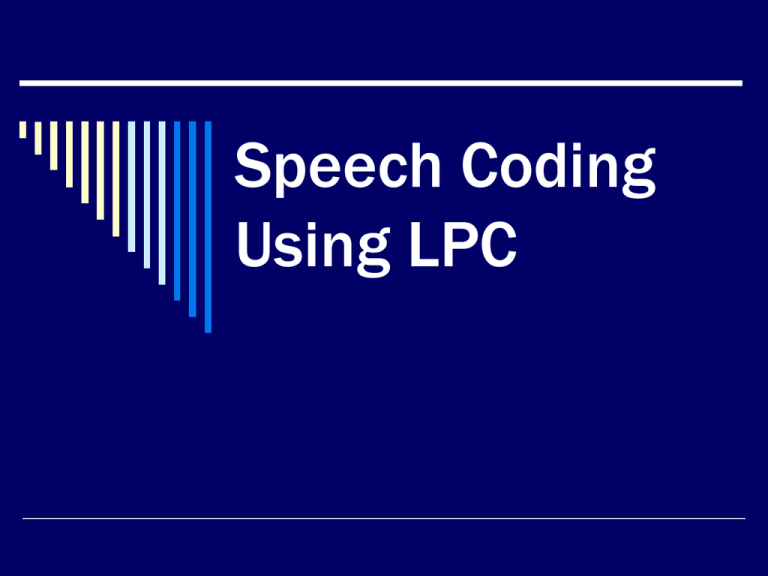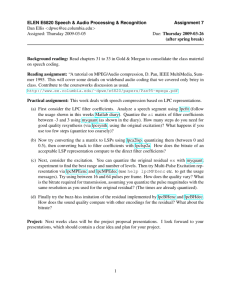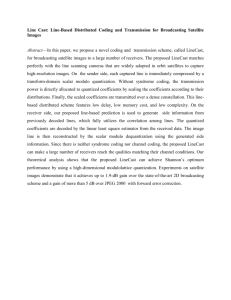Speech Coding
advertisement

Speech Coding Using LPC What is Speech Coding Speech coding is the procedure of transforming speech signal into more compact form for Transmission Available Bandwidth Encryption Uncompressed Speech signal Analog speech is a bandpassed signal between 200 and 3400 Hz. Uncompressed digital speech is a bit stream at 64kB/s. Transmission technology must transmit the signals from point A to point B: with minimum degradation using minimum bandwidth Speech coding By coding we mean an efficient representation of the signal – COMPRESSION The main approaches: waveform coding smart quantizers transform coding Parametric / hybrid coding } How each of these works: Waveform coders: try to find an efficient representation of the waveform, directly. Transform coders: try to find an efficient representation in the frequency domain. FFT, etc. Parametric coders: try to find a small set of parameters that are an efficient representation of the signal. exc. H ( ) speech Comparison of speech coders LPC (Linear Predictive coding) LPC is a model for signal production: it is based on the assumption that the speech signal is produced by a very specific model. Speech Production in Humans The speech signal is created by: A pressure source (lungs), exciting ... A Filter (Vocal tract: pharynx - mouth [soft palate, tongue] - nasal cavity) For DSP Engineer An excitation source A time varying filter filter: Excitation speech H(t, ) The model and its representation The LPC model looks at speech as: Excitation: periodic (voiced) originating in the larynx noise (unvoiced) fricative, produced in the mouth An all-pole filter representing the vocal tract .. .. all pole filter: H() Block Diagram Why the name “Linear Predictive Coding” It is assumed that the new sample is the weighted linear combination of previous samples p s (n) a s (n i ) Ge(n) i i 1 Z-Plane Representation In the z-plane we can write the model as a transfer function: H(z) G p 1 ai z i i 1 • Clearly this transfer function has only poles which is why it represents an all pole filter. Mathematical analysis Reminder: our problem is to find the LPC parameters, for a given speech signal. This is called the Inverse Problem. How do we find the set of parameters that gives the best match to the signal? What are these Parameters The Coefficients of the All Pole Filter Pitch of the speech How do we find the Coefficients: least squares Formulation: Given a signal s(n); Defining an error as: Find the set of square error: ai e(n) s(n) ai s(n i) i 1 that will minize the mean E e2 ( n) n p Solution: Simply equate the derivative of E to zero: E 0, i 1... p ai • Which gives us the Normal Equations: p a s(n k )s(n i) s(n)s(n i), i 1...p k 1 k n n • These are no more than p linear equations in p unknowns... Or in matricial form: s(n 1) s(n 1) n s(n 2) s(n 1) n s(n p) s(n 1) n s(n 1)s(n 2) s(n 2)s(n 2) n n n s(n p)s(n 2) n s(n 1)s(n p) a s(n 1)s(n) s(n 2)s(n p) a s(n 2)s(n) n 1 2 a n s(n p)s(n p) p n n s ( n p ) s ( n ) n What is each element of the form- s(n k )s(n i)? n A correlation; in other words: take the signal, multiply it by a shifted version, and sum. Since our signal is long and time varying- we did it on short windows Two variants: autocorrelation method covariance method Solving the Matrix Found the Coefficients a(i) by Using the Levinson-Durbin recursion method Second Parameter Pitch was found by the finding the correlation of the signal window with itself Then these parameters were transmitted Predictor coefficients Gain Pitch period Voiced/unvoiced switch Total Overall bit rate 18 * 8 = 144 5 6 1 156 50 * 156 = 7800 bits / second Bit rate for plain LPC vocoder Predictor coefficients Gain DCT coefficients Total Overall bit rate 18 * 8 = 144 5 40 * 4 = 160 309 50 * 309 = 15450 bits / second Bit rate for voice-excited LPC vocoder with DCT Conclusion Sound produced through LPC method is not exactly the real sound but it sounds intelligibly understandable LPC can be used in Speech recognition systems LPC was widely used in Military because of low bit rate in transmission There are many variants over the basic scheme: LPC-10, CELP, MELP, RELP, VSELP, ASELP, LD-CELP...











